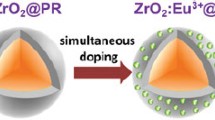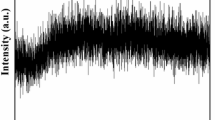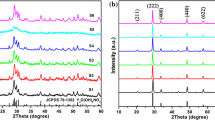Abstract
Solid and hollow YF3:Eu3+ spheres assembled by nanorods have been successfully synthesized via a facile arginine-assisted hydrothermal method and followed by a subsequent heat-treatment process. The experimental results reveal that the as-prepared YF3:Eu3+ spheres are composed of the nanorods with a diameter of 20–50 nm and a length of 200–500 nm, the morphologies of YF3:Eu3+ have been changed from solid to hollow spheres assembled by nanorods. With increase of hydrothermal temperature and time, the diameter of YF3:Eu3+ spheres can be controlled from 300 to 800 nm. The solid and hollow spheres show an intense orange red emission peak near 595 nm, corresponding to the 5D0 → 7F1 transition of Eu3+. The possible formation mechanism for the hollow spheres has been presented in detail. This amine acid-assisted method is very simple, economic and environmental friendly for organic-free solvent, which would be potentially used in synthesizing other hollow materials.












Similar content being viewed by others
References
Bao JC, Liang YY, Xu Z, Si L (2003) Facile synthesis of hollow nickel submicrometer spheres. Adv Mater 15:1832–1835. doi:10.1002/adma.200305315
Burford N, Eelman MD, Mahony DE, Morash M (2003) Definitive identification of cysteine and glutathione complexes of bismuth by mass spectrometry: assessing the biochemical fate of bismuth pharmaceutical agents. Chem Commun 146–147. doi:10.1039/b210570e
Cao CY, Qin WP, Zhang JS (2008) Enhanced ultraviolet up-conversion emissions of Tm3+/Yb3+ codoped YF3 nanocrystals. J Fluor Chem 129:204–209. doi:10.1016/j.jfluchem.2007.11.002->
Caruso F, Caruso RA, Mohwald H (1998) Nanoengineering of inorganic and hybrid hollow spheres by colloidal templating. Science 282:1111–1114
Chen XY, Zhang XF, Shi CW, Li XL, Qian YT (2005) A simple biomolecule-assisted hydrothermal approach to antimony sulfide nanowires. Solid State Commun 134:613–615. doi:10.1016/j.ssc.2005.03.004
Cong HP, Yu SH (2007) Hybrid ZnO-dye hollow spheres with new optical properties by a self-assembly process based on evans blue dye and cetyltrimethylammonium bromide. Adv Funct Mater 17:1814–1820. doi:10.1002/adfm.200601082
Huang JX, Xie Y, Li B, Liu Y, Qian YT, Zhang SY (2000) In situ Source–Template–Interface reaction route to semiconductor CdS submicrometer hollow spheres. Adv Mater 12:808–811. doi:10.1002/(SICI)1521-4095(200006)
Ikeda S, Ishino S, Harada T, Okamoto N, Sakata T, Mori H, Kuwabata S, Torimoto T, Matsumura M (2006) Ligand-free platinum nanoparticles encapsulated in a hollow porous carbon shell as a highly active heterogeneous hydrogenation catalyst. Angew Chem Int Ed 45:7063–7066. doi:10.1002/anie.200602700
Jia G, Yang M, Song YH, You HP, Zhang HJ (2009) General and facile method to prepare uniform Y2O3:Eu hollow microspheres. Cryst Growth Des 9(1):301–307
Jia G, You HP, Liu K, Zheng YH, Guo N, Zhang HJ (2010) Highly uniform Gd2O3 hollow microspheres: template-directed synthesis and luminescence properties. Langmuir 26(7):5122–5128
Jiang P, Bertone JF, Colvin VL (2001) A lost-wax approach to monodisperse colloids and their crystals. Science 291:453–457
Li XL, Lou TJ, Sun XM, Li YD (2004) Highly sensitive WO3 hollow-sphere gas sensors. Inorg Chem 43:5442–5449. doi:10.1021/ic049522w
Li YC, Chang YH, Lin YF, Chang YS, Lin YJ (2007) Synthesis and luminescent properties of Ln3+ (Eu3+, Sm3+, Dy3+)-doped lanthanum aluminum germanate LaAlGe2O7 phosphors. J Alloys Compd 439(1–2):367–375. doi:10.1016/j.jallcom.2006.08.269
Lorbeer C, Cybinska J, Mudring AV (2010) Facile preparation of quantum cutting GdF3:Eu3+ nanoparticles from ionic liquids. Chem Commun 46:571–572. doi:10.1039/b919732j
Lou XW, Archer LA (2008) A general route for non-spherical anatase TiO2 hollow colloids and magnetic multifunctinal particls. Adv Mater 20:1853–1858
Mayers B, Xia YN (2002) One-dimensional nanostructures of trigonal tellurium with various morphologies can be synthesized using a solution-phase approach. J Mater Chem 12:1875–1881. doi:10.1039/B201058E
Peng Q, Dong Y, Li Y (2003) ZnSe semiconductor hollow microspheres. Angew Chem Int Ed 42:3027–3030
Putlitz BZ, Landfester K, Fischer H, Antonietti M (2001) The generation of “armored latexes” and hollow inorganic shells made of clay sheets by templating cationic miniemulsions and latexes. Adv Mater 13:500–503. doi:10.1002/1521-4095(200104)
Sillen LG, Martell AE (1964) Stability constants of metal-ion complexes. Chem Soc London Spec Publ 17
Sillen LG, Martell AE (1971) Stability constants of metal-ion complexes. Chem Soc London Spec Publ 25
Stumm W, Morgan JJ (1981) Aquatic Chemistry. An introduction emphasizing chemical equilibriain natural waters, seconded. Wiley-Interscience, NY
Stumm W, Huang P, Jenkins R (1970) Specific chemical interactions affecting the stability of dispersed systems. Croat Chem Acta 42:223–244
Tao F, Wang ZJ, Yao LZ (2007) Synthesis and photoluminescence properties of truncated octahedral Eu-doped YF3 submicrocrystals or nanocrystals. J Phys Chem C 111(8):3241–3245. doi:10.1021/jp065905z
Wang X, Li Y (2003) Fullerene-like rare-earth nanoparticles. Angew Chem Int Ed 42:3497–3500
Wang W, Fu XA, Tang JA, Jiang L (1993) Preparation of submicron spherical particles of silica by the water-in-oil microemulsion method. Colloids Surf A 81:177–180. doi:10.1016/0927-7757(93)80244-9
Wang GF, Qin WP, Zhang JS (2008a) Enhancement of violet and ultraviolet upconversion emissions in Yb3+/Er3+-codoped YF3 nanocrystals. Opt Mater 31:296–299. doi:10.1016/j.optmat.2008.04.013
Wang GF, Qin WP, Zhang JS (2008b) Synthesis and spectral properties of Eu3+-doped YF3 nanobundles. J Fluor Chem 129:621–624. doi:10.1016/j.jfluchem.2008.05.003
Wang SJ, Xu HL, Chen XS (2008c) Solvothermal synthesis of disk-like YF3 superstructures. J Cryst Growth 310:4697–4700. doi:10.1016/j.jcrysgro.2008.09.003
Wang ZL, Lin J, Li M (2009) Photoluminescence properties of LaF3:Eu3+ nanoparticles prepared by refluxing method. J Rare Earths 27(1):33–37. doi:10.1016/S1002-0721(08)60185-4
Wei W, Ma GH, Hu G, Yu D, Mcleish T, Su ZG, Shen ZY (2008) Preparation of hierarchical hollow CaCO3 particles and the application as anticancer drug carrier. J Am Chem Soc 130:15808–15810. doi:10.1021/ja8039585
Wu Q, Chen Y, Xiao P, Zhang F, Wang XZ, Hu Z (2008) Hydrothermal synthesis of cerium fluoride hollow nanostructures in a controlled growth microenvironment. J Phys Chem C 112:9604–9609. doi:10.1021/jp800838y
Xiong SL, Xi BJ (2007) Synthesis of 3D and 1D structures of CdS in a binary solution with l-cysteine’s assistance. Chem Eur J 13:3076–3081
Yan RX, Li YD (2005) Down/up conversion in Ln3+-doped YF3 nanocrystals. Adv Funct Mater 15:763–770. doi:10.1002/adfm.200305044
Yan E, Ding Y, Chen C, Li R, Hu Y, Jiang X (2009) Polymer/silica hybrid hollow nanospheres with pH-sensitive drug release in physiological and intracellular environments. Chem Commun 2718–2720
Yang J, Li CX, Quan ZW, Zhang CM, Yang PP, Li YY, Yu CC, Lin J (2008) Self-assembled 3D flowerlike Lu2O3 and Lu2O3:Ln3+ (Ln = Eu, Tb, Dy, Pr, Sm, Er, Ho, Tm) microarchitectures: ethylene glycol-mediated hydrothermal synthesis and luminescent properties. J Phys Chem C 112:12777–12785. doi:10.1021/jp803945w
Zhang D, Qi L, Ma J, Cheng H (2002) Synthesis of submicrometer-sized hollow silver spheres in mixed polymer-surfactant solutions. Adv Mater 14:1499–1502
Zhang B, Ye XC, Hou WY, Zhao Y, Xie Y (2006a) Biomolecule-assisted synthesis and electrochemical hydrogen storage of Bi2S3 flowerlike patterns with well-aligned nanorods. J Phys Chem B 110:8978–8985. doi:10.1021/jp060769j
Zhang GJ, Shen ZR, Liu M (2006b) Synthesis and characterization of mesoporous ceria with hierarchical nanoarchitecture controlled by amino acids. J Phys Chem B 110:25782–25790. doi:10.1021/jp0648285
Zhang LH, Jia G, You HP, Liu K, Yang M, Song YH, Zheng YH, Huang YJ, Guo N, Zhang HJ (2010) Sacrificial template method for fabrication of submicrometer-sized YPO4:Eu3+ hierarchical hollow spheres. Inorg Chem 49:3305–3309. doi:10.1021/ic9022739
Zhong SL, Wang SJ, Xu HL (2009) Facile synthesis of water-soluble YF3 and YF3: Ln3+ nanocrystals. Mater Lett 63:530–532. doi:10.1016/j.matlet.2008.11.003
Zhu YF, Shi JL, Shen WH, Dong XP, Feng JW, Ruan ML, Li YS (2005) Novel stimuli-responsive controlled drug release from a hollow mesoporous silica sphere/polyelectrolyte multilayers core-shell structure. Angew Chem Int Ed 44:5083–5087
Acknowledgments
This work was financially supported by National Nature Science Foundation of China (NSFC 51072026, 40675083) and the Science and Technology Development Planning Project of Jilin Province (grant No. 20090528).
Author information
Authors and Affiliations
Corresponding author
Rights and permissions
About this article
Cite this article
Liu, G., Li, X., Dong, X. et al. Architectures of YF3:Eu3+ solid and hollow sub-microspheres: a facile arginine-assisted hydrothermal synthesis and luminescence properties. J Nanopart Res 13, 4025–4034 (2011). https://doi.org/10.1007/s11051-011-0332-0
Received:
Accepted:
Published:
Issue Date:
DOI: https://doi.org/10.1007/s11051-011-0332-0




